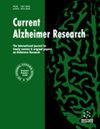Blood Biomarkers Predict Future Cognitive Decline after Military-Related Traumatic Brain Injury.
IF 1.8
4区 医学
Q3 CLINICAL NEUROLOGY
引用次数: 1
Abstract
BACKGROUND Traumatic brain injury (TBI) has been associated with increased likelihood of late-life dementia; however, the mechanisms driving this relationship are elusive. Blood-based biomarkers may provide insight into these mechanisms and serve as useful prognostic indicators of cognitive recovery or decline following a TBI. OBJECTIVE The aim of this study was to examine blood biomarkers within one year of TBI and explore their relationship with cognitive decline. METHODS Service members and veterans (n=224) without injury (n=77), or with history of bodily injury (n=37), uncomplicated mild TBI (n=55), or more severe TBI (n=55), underwent a blood draw and neuropsychological assessment within one year of their injury as part of a case-control study. A subsample (n=87) completed follow-up cognitive assessment. RESULTS In the more severe TBI group, baseline glial fibrillary acidic protein (p=.008) and ubiquitin C-terminal hydrolase-L1 (p=.026) were associated with processing speed at baseline, and baseline ubiquitin C-terminal hydrolase-L1 predicted change in immediate (R2Δ=.244, p=.005) and delayed memory (R2Δ=.390, p=.003) over time. In the mild TBI group, higher baseline tau predicted greater negative change in perceptual reasoning (R2Δ=.188, p=.033) and executive functioning (R2Δ=.298, p=.007); higher baseline neurofilament light predicted greater negative change in perceptual reasoning (R2Δ=.211, p=.012). CONCLUSION Baseline ubiquitin C-terminal hydrolase-L1 strongly predicted memory decline in the more severe TBI group, while tau and neurofilament light strongly predicted decline in the mild TBI group. A panel including these biomarkers could be particularly helpful in identifying those at risk for future cognitive decline following TBI.血液生物标志物预测与军事有关的创伤性脑损伤后未来的认知能力下降。
背景:创伤性脑损伤(TBI)与老年痴呆的可能性增加有关;然而,驱动这种关系的机制是难以捉摸的。基于血液的生物标记物可能为这些机制提供深入的见解,并作为脑外伤后认知恢复或衰退的有用预后指标。目的:本研究旨在检测脑外伤患者一年内的血液生物标志物,并探讨其与认知能力下降的关系。方法224名无外伤(n=77)、有身体外伤史(n=37)、无并发症的轻度TBI (n=55)或较严重的TBI (n=55)的服役人员和退伍军人(n=224)在受伤后一年内接受抽血和神经心理学评估,作为病例对照研究的一部分。一个子样本(n=87)完成了后续认知评估。结果在较严重的TBI组,基线胶质纤维酸性蛋白(p= 0.008)和泛素c末端水解酶- l1 (p= 0.026)与基线处理速度相关,基线泛素c末端水解酶- l1预测即时变化(R2Δ= 0.026)。244, p=.005)和延迟内存(R2Δ=. 005)。390, p=.003)。在轻度TBI组中,较高的基线tau预示着知觉推理的更大的负面变化(R2Δ=。188, p= 0.033)和执行功能(R2Δ= 0.033)。298年,p = .007);基线神经丝光越高,感知推理的负面变化越大(R2Δ=。211年,p = .012)。结论基线泛素c端水解酶- l1能预测较重度TBI组的记忆衰退,而tau和神经丝光能预测轻度TBI组的记忆衰退。一个包括这些生物标记物的小组可能特别有助于识别那些在TBI后有认知能力下降风险的人。
本文章由计算机程序翻译,如有差异,请以英文原文为准。
求助全文
约1分钟内获得全文
求助全文
来源期刊

Current Alzheimer research
医学-神经科学
CiteScore
4.00
自引率
4.80%
发文量
64
审稿时长
4-8 weeks
期刊介绍:
Current Alzheimer Research publishes peer-reviewed frontier review, research, drug clinical trial studies and letter articles on all areas of Alzheimer’s disease. This multidisciplinary journal will help in understanding the neurobiology, genetics, pathogenesis, and treatment strategies of Alzheimer’s disease. The journal publishes objective reviews written by experts and leaders actively engaged in research using cellular, molecular, and animal models. The journal also covers original articles on recent research in fast emerging areas of molecular diagnostics, brain imaging, drug development and discovery, and clinical aspects of Alzheimer’s disease. Manuscripts are encouraged that relate to the synergistic mechanism of Alzheimer''s disease with other dementia and neurodegenerative disorders. Book reviews, meeting reports and letters-to-the-editor are also published. The journal is essential reading for researchers, educators and physicians with interest in age-related dementia and Alzheimer’s disease. Current Alzheimer Research provides a comprehensive ''bird''s-eye view'' of the current state of Alzheimer''s research for neuroscientists, clinicians, health science planners, granting, caregivers and families of this devastating disease.
 求助内容:
求助内容: 应助结果提醒方式:
应助结果提醒方式:


